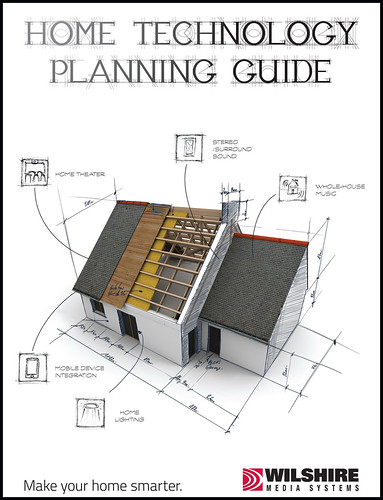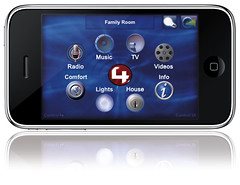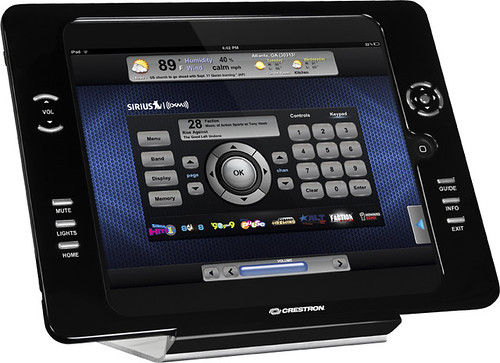 Taking control of your lifestyle and the various systems in your home is much easier and more affordable than ever.
Taking control of your lifestyle and the various systems in your home is much easier and more affordable than ever.
Home control refers to technologies that can link and control all the equipment and systems in your home. Imagine having one controller that can:
- Automatically turn off all the TVs in the house when the kids are doing their homework.
- Alert you that the garage door is open and then let you close it from your iPhone.
- Manage your lights, window coverings and thermostats to reduce your energy bills.
- Monitor and arm your door locks, lights and security cameras anywhere you are.
- View your vacation home from your office, primary home or mobile device.
These are just a few examples of the todays control systems capabilities, and there are many more possibilities available at a multitude of price points. We can adapt to your needs and design a system that delivers on your expectations and fits your budget. Design is the most critical step in having a system that functions flawlessly and delivers on your expectations.
The process of home automation works by making everything in the house that can be automatically controlled using technology do the jobs that we would normally do manually. It is much easier to install home automation in a house while it is still being built, since you have the ability to put things inside the walls to save space. If your house is already finished, you can still have home automation done in a less-intrusive way through the use of wireless technology. Wired systems are generally more robust than wireless, but wireless technology has come a long way.
still being built, since you have the ability to put things inside the walls to save space. If your house is already finished, you can still have home automation done in a less-intrusive way through the use of wireless technology. Wired systems are generally more robust than wireless, but wireless technology has come a long way.
Home automation can perform tasks as simple as turning on the sprinklers at a certain time every day, or lowering the blinds as the sun sets through the windows of your home. One of the first decisions you should make when considering home automation products is, what systems in your home would you like to control? These systems are best understood when they are broken down into subsystems.
Entertainment
This subsystem is usually the first one everyone wants to control, because each different component in an entertainment system comes with its own remote. Replacing all your remotes with one controller is the quickest way for everyone to begin to enjoy their home entertainment. Another big advantage is having the ability to move your music to any ro om in the home or having the movie you are watching follow you to another TV in a different part of the house.
Climate
Climate subsystems can be managed according to the time of day, or they can detect open doors or windows and shut down the HVAC system until they are closed. Some systems even offer you your own weather station to tell you wind speed, inside and outside temperature, humidity at your location and much more. Programmable thermostats address comfort and efficiency by maintaining a schedule consistent with your familys presence in the home.
Lightin g and Shades
g and Shades
Controlling your lights allows you to create environments that optimize activities. Control systems can light your hallway for ease of access at night or turn on the landscape lighting as the sun sets. Shade systems can follow the sun as it rises or sets to optimize energy efficiency and maximize natural light. The possibilities for lighting-based control are endless.
Security
Security and alarm systems normally address most of the safety issues in the home environment. Adding control of security lighting at night can prevent unwanted accidents such as falling down the stairs or add to the burglary deterrent by flashing exterior lights when motion is detected. You can also use security sensors to trigger climate and lighting scenes in case the alarm system is armed or disarmed. Imagine having your driveway light up as you pull onto your property, then your interior lights turn on and your security system deactivates as you enter the home.
Home Data Network
Increasingly home automation systems are being designed to utilize the home data network to pass control information or stream digital media as mentioned above. This subsystem will play a larger role over time allowing the integration of entertainment, computing and appliances into a coordinated home network .
 Controllers
Controllers
The most important piece of the home control and automation puzzle is how you and your family will operate all of these technologies. Controllers are the devices you will use and they can range from the traditional hand-held remote control, to keypad devices, all the way to touch-screen interfaces with customized designs. The more advanced the device becomes, the simpler the operation of your various subsystems.
Replacing all remotes with one controller is the quickest way to enjoying your home entertainment.
The least expensive type of control device is a hand-held remote, and unlike the universal controllers you may already be familiar with, these programmable remotes allow you to do much more than just learn the commands of the devices in your home. Many can control lighting as well as entertainment functions and additionally, they have the capability of executing scenes or macros.
Keypads are the second type of control system and these can be made to be portable like the handheld devices previously mentioned, but they can also be installed in a wall. They are available in many types and sizes, but the most common are three and six button systems. They are also available in a variety of colors to match your d
